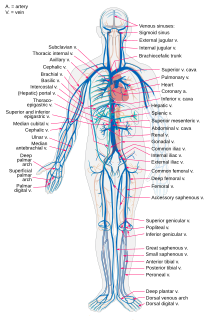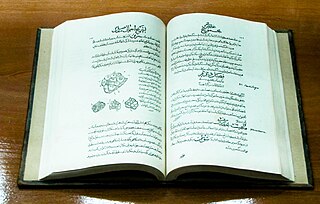Related Research Articles

Aelius Galenus or Claudius Galenus, often Anglicized as Galen and sometimes known as Galen of Pergamon, was a Greek physician, surgeon and philosopher in the Roman Empire. Considered to be one of the most accomplished of all medical researchers of antiquity, Galen influenced the development of various scientific disciplines, including anatomy, physiology, pathology, pharmacology, and neurology, as well as philosophy and logic.

The heart is a muscular organ in most animals, which pumps blood through the blood vessels of the circulatory system. The pumped blood carries oxygen and nutrients to the body, while carrying metabolic waste such as carbon dioxide to the lungs. In humans, the heart is approximately the size of a closed fist and is located between the lungs, in the middle compartment of the chest.

William Harvey was an English physician who made influential contributions in anatomy and physiology. He was the first known physician to describe completely, and in detail, the systemic circulation and properties of blood being pumped to the brain and the rest of the body by the heart, though earlier writers, such as Realdo Colombo, Michael Servetus, and Jacques Dubois, had provided precursors of the theory.

Veins are blood vessels that carry blood towards the heart. Most veins carry deoxygenated blood from the tissues back to the heart; exceptions are the pulmonary and umbilical veins, both of which carry oxygenated blood to the heart. In contrast to veins, arteries carry blood away from the heart.

The circulatory system, also called the cardiovascular system or the vascular system, is an organ system that permits blood to circulate and transport nutrients, oxygen, carbon dioxide, hormones, and blood cells to and from the cells in the body to provide nourishment and help in fighting diseases, stabilize temperature and pH, and maintain homeostasis.

The Canon of Medicine is an encyclopedia of medicine in five books compiled by Persian Muslim physician-philosopher Avicenna and completed in 1025. It presents an overview of the contemporary medical knowledge of the Islamic world, which had been influenced by earlier traditions including Greco-Roman medicine, Persian medicine, Chinese medicine and Indian medicine.

Pulmonology or pneumology is a medical specialty that deals with diseases involving the respiratory tract. It is also known as respirology, respiratory medicine, or chest medicine in some countries and areas.

Arabic epic literature encompasses epic poetry and epic fantasy in Arabic literature. Virtually all societies have developed folk tales encompassing tales of heroes. Although many of these are legends, many are based on real events and historical figures.

The mammalian heart is divided between the systemic and the pulmonary circulation, generally agreed upon as left and right sided circuits. The right circuit is the portion of the circulatory system which carries deoxygenated blood away from the right ventricle, to the lungs, and returns oxygenated blood to the left atrium and ventricle of the heart. The term pulmonary circulation is readily paired and contrasted with the systemic circulation. The vessels of the pulmonary circulation are the pulmonary arteries and the pulmonary veins.

The atrium is the upper chamber through which blood enters the ventricles of the heart. There are two atria in the human heart – the left atrium receives blood from the pulmonary (lung) circulation, and the right atrium receives blood from the venae cavae. The atria receive blood while relaxed (diastole), then contract (systole) to move blood to the ventricles. All animals with a closed circulatory system have at least one atrium. Humans have two atria.
Jamal al-Din Muhammad ibn Muhammad ibn Muhammad ibn Fakhr al-Din al-Razi, also written al-Aqsara'i, was a 14th-century Muslim Persian physician. He became known as Aqsara'i because he moved to Aqsara region of what is now Turkey.

In the history of medicine, "Islamic medicine" is the science of medicine developed in the Middle East, and usually written in Arabic, the lingua franca of Islamic civilization. The term "Islamic medicine" has been objected as inaccurate, since many texts originated from non-Islamic environment, such as Pre-Islamic Persia, Jews or Christian.

Ala-al-Din abu al-Hasan Ali ibn Abi-Hazm al-Qarshi al-Dimashqi, known as Ibn al-Nafis, was an Arab polymath whose areas of work included medicine, surgery, physiology, anatomy, biology, Islamic studies, jurisprudence, and philosophy. He is known for being the first to describe the pulmonary circulation of the blood. The work of Ibn al-Nafis regarding the right sided (pulmonary) circulation pre-dates the later work (1628) of William Harvey's De motu cordis. Both theories attempt to explain circulation. 2nd century Greek physician Galen's theory about the physiology of the circulatory system remained unchallenged until the works of Ibn al-Nafis, for which he has been described as "the father of circulatory physiology".

A bimaristan, also known as dar al-shifa or simply maristan, is a hospital in the historic Islamic world.
Theologus Autodidactus, originally titled The Treatise of Kāmil on the Prophet's Biography, also known as Risālat Fādil ibn Nātiq, is a theological novel written by Ibn al-Nafis. This work is one of the first Arabic novels, may be considered a prototypical science fiction novel, of which it contained numerous elements, and an early example of a coming of age tale and a desert island story. This novel was written sometime between 1268 and 1277. It was partly a response to the philosophical novel Hayy ibn Yaqdhan by Andalusi writer Ibn Tufail.
The history of pathology can be traced to the earliest application of the scientific method to the field of medicine, a development which occurred in the Middle East during the Islamic Golden Age and in Western Europe during the Italian Renaissance.

Paul Ghalioungui or Ghalioungi (1908–1987), MD (Cairo), MRCP (Lond), Professor of Medicine and former Chairman of Internal Medicine department, Ain Shams University Faculty of Medicine. An Egyptian endocrinologist, historian of Egyptian medicine, Egyptologist and an authority on Pharaonic medicine, he wrote a vivid history of Egyptian medicine in English, French, Arabic, German, and Spanish.
Andrea Alpago was an Italian physician and arabist. In publications of his work in Latin his name is frequently given as Andreas Alpagus Bellunensis, where "Bellunensis" refers to his birthplace of Belluno in northeastern Italy. Not much is truly known about his childhood nor his time in medical school. However, it is commonly assumed that his school was completed in Padua. Around the year 1487, Andrea Alpago moved to go work in the city of Damascus in Syria as physician to the consulate of Republic of Venice as the successor to Girolamo Ramusio. While working for the consulate, Alpago became a friend and mentee to Ibn al-Makkī. This friendship strongly influenced Alpago's career as Ibn al-Makkī introduced him to Avicenna's work. His translations of Avicenna's work from Arabic to Latin as possible one of his greatest and most well-known achievements from his lifetime. This work allowed for greater transmission of knowledge and Islamicate work to European and Latin speaking countries. Alpago completed these translations primarily to increase textual issues that may arise in translation in order to better explain a topic. This same translating ability also gave him new opportunities while working for the Venetian Consulate. Alpago was occasionally sent to do non-medical work and translations, however, Alpago was already interested in learning new cultures and customs so it was no issue to him. He would send work back to the Venetian consulate detailing subjects such as the economy and culture in letters. During this time, Alpago became very close with the Arabic physicians, it is thought he sympathized with the Safavid Dynasty due to their struggles with the Ottomans. After nearly twenty years working for the consulate in Damascus, Alpago almost left the consulate in 1507 to move back to Belluno, however, due his disagreement with the man who was supposed to replace him, he stayed until 1517. At this time, his nephew, Paulo Alpago, traveled with him to the consulate of Nicosia in Cyprus. Alpago stayed in Cyprus until December of 1520 when he eventually traveled back to Venice. During his travel to and from Venice, he ventured through various Arabic countries to find manuscripts, learn culture, and better understand languages. Upon his return to Venice, Alpago was appointed professor of medicine in Padua in northeastern Italy in September of 1521, confirmed by the Venetian senate. Unfortunately, after only two to three months of working at the University, Andrea Alpago died after a dinner. Alpago had not published ay of his work during his life but after his death they were published on the initiative of his nephew Paolo Alpago. This library included several books as well as pamphlets. His best known work is his commentary and editing of the Latin translation of The Canon of Medicine of Ibn Sina. This medicine book was translated from Arabic to Latin in the late 12th century by Gerard of Cremona. Andrea Alpago's edition and supplements to Gerard of Cremona's translation was widely read in European medical circles during the 16th century. It was first published in 1527 and an expanded edition was published in 1544. The Canon thoroughly explains as well as illustrates many vital parts of medicine including but not limited to anatomy and pharmacology. Although he only had about twelve corrections, they were done in an effort to make the translation make more sense when read in the other language. He did not change the meaning or purpose of any of the statements made by Gerard, regardless if he believed had the same view or not. The corrections he made were to simply clarify his translations. In addition to The Cannon of Medicine, Andrea Alpago's translation of Avicenna's philosophical work was historic for the time. Alpago explained major points of Avicenna's work on philosophy and Islam while occasionally relating it back to christianity. Although Alpago did not like to change much when translating, he found it necessary to make some corrections with medical texts. Because many of the manuscripts were very old, Alpago found it necessary to correct some of the manuscripts because it was dealing with human life and should not endanger a person.
Christianismi Restitutio was a book published in 1553 by Michael Servetus. It rejected the Christian doctrine of the Trinity and the concept of predestination, which had both been considered fundamental to Christianity since the time of St. Augustine and emphasized by John Calvin in his magnum opus, Institutio Christianae Religionis. Servetus argued that God condemns no one who does not condemn himself through thought, word or deed. It also contained, incidentally and by way of illustration, groundbreaking views on pulmonary circulation based on the discoveries of Arab Muslim physician Ibn Al Nafis, that challenged the incorrect teachings of Galen.
References
- 1 2 3 West, John (1985). "Ibn al-Nafis, the pulmonary circulation, and the Islamic Golden Age". Journal of Applied Physiology . 105 (6): 1877–1880. doi:10.1152/japplphysiol.91171.2008. PMC 2612469 . PMID 18845773.
- ↑ Bondke Persson, A.; Persson, P. B. (2014). "Form and function in the vascular system". Acta Physiologica . 211 (3): 468–470. doi:10.1111/apha.12309. PMID 24800879. S2CID 26211642.
- ↑ Bosmia, Anand; Watanabe, Koichi; Shoja, Mohammadali M.; Loukas, Marios; Tubbs, R. Shane (2013). "Michael Servetus (1511–1553): Physician and heretic who described the pulmonary circulation". International Journal of Cardiology . 167 (2): 318–321. doi:10.1016/j.ijcard.2012.06.046. PMID 22748500.
“It is possible that Al-Nafis' book was known in 16th century Europe, for Andrea Alapago returned from thirty years in Arabia to Padua in 1520 with a Latin translation of the commentary
- ↑ Michelakis, E. D. (19 June 2014). "Pulmonary Arterial Hypertension: Yesterday, Today, Tomorrow". Circulation Research . 115 (1): 109–114. doi: 10.1161/CIRCRESAHA.115.301132 . PMID 24951761.